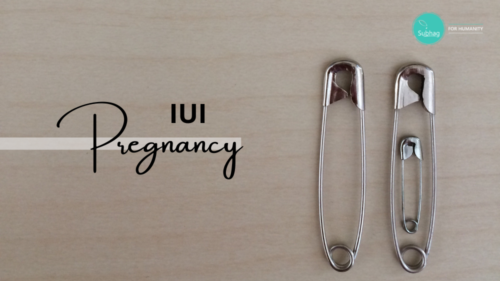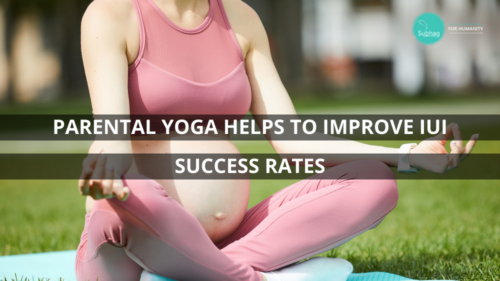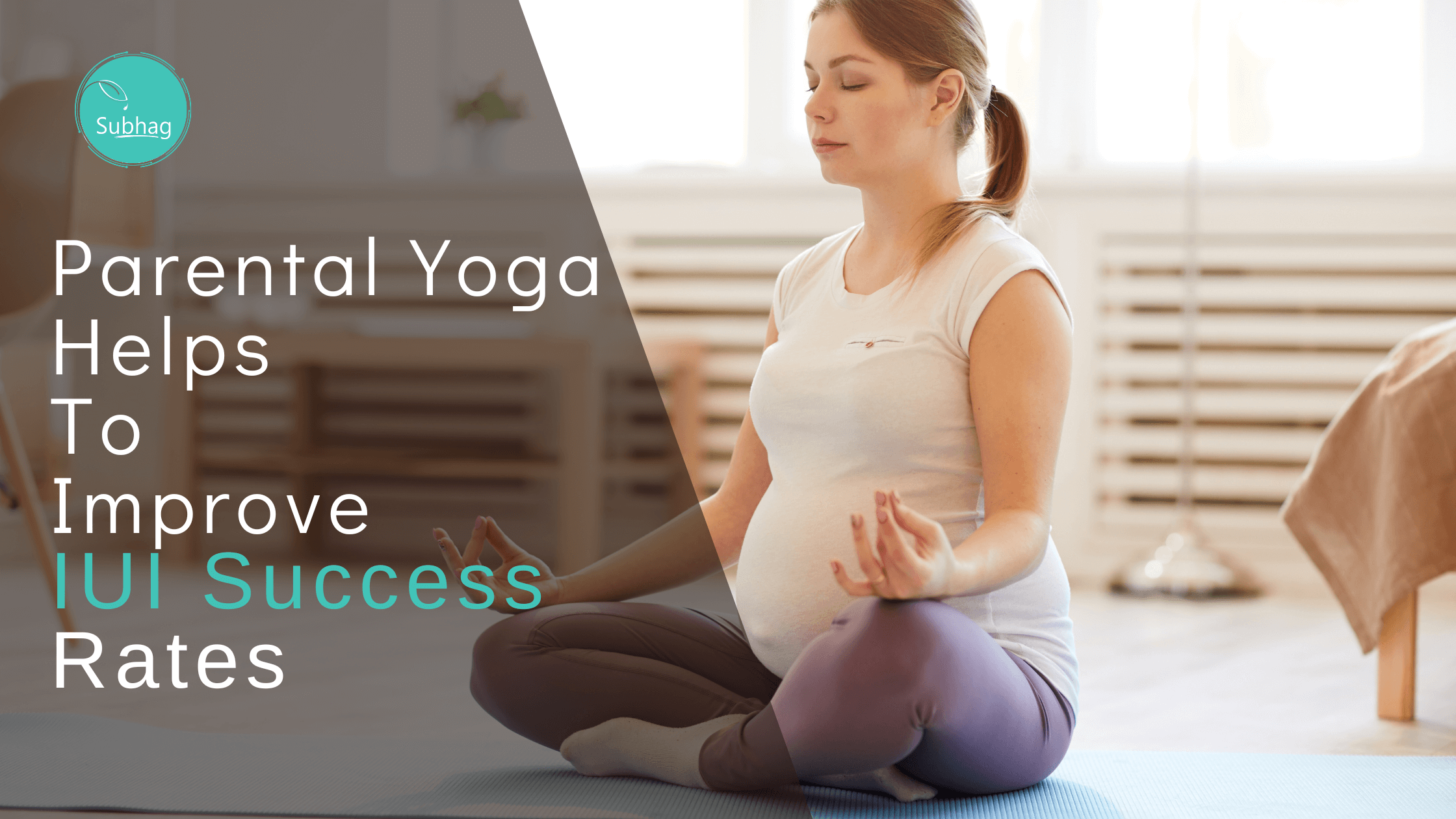Prenatal yoga is a good option if you’re pregnant and searching for a method to relax or keep in shape. But did you know that prenatal yoga can increase IUI success rates, help you prepare for labor, and improve the health of your baby?
Understand the breadth of potential advantages, as well as what a typical class comprises critical safety considerations, before beginning prenatal yoga.
Everything That You Need To Know About Parental Yoga
What Happens During A Typical Prenatal Yoga Class?
A typical prenatal yoga class might involve:
Taking a Deep Breath
You’ll be told to concentrate on breathing slowly and deeply through your nose. Prenatal yoga breathing methods may help you lessen or manage shortness of breath when pregnant, as well as work through labor contractions.

Stretching should be done Gently
Different parts of your body, such as your neck and arms, will be gently moved through their full range of motion.
Postures
You’ll gently move your body into different postures while standing, sitting, or lying on the ground in order to improve your IUI success rates, strength, flexibility, and balance. To give support and comfort, props like blankets, cushions, and belts can be employed.
Relax and Cool Down
You’ll relax your muscles and restore your resting heart rate and breathing rhythm at the end of each prenatal yoga class. To achieve a condition of self-awareness and inner peace, you may be encouraged to listen to your own breathing, pay special attention to sensations, thoughts, and emotions, or repeat a mantra or word.
What Are The Benefits Of Prenatal Yoga?
Prenatal yoga is a comprehensive approach to fitness that will help IUI success rates and that involves stretching, mental centering, and concentrated breathing, similar to other types of birthing preparation sessions. Prenatal yoga appears to be safe for pregnant women and their newborns, according to research.
Prenatal yoga appears to be a healthy practice to engage in while pregnant, and it is. But, more precisely, how can prenatal yoga help you increase your IUI success rates and feel good, and stay calm during the most crucial nine months of your life? Continue reading to see how yoga can help you feel better during your pregnancy.
Benefits of Prenatal yoga
- Improve sleep
- Reduce stress and anxiety
- Increase the strength, flexibility, and endurance of muscles needed for childbirth
- Decrease lower back pain, nausea, headaches, and shortness of breath
- Prenatal yoga can also help you meet and bond with other pregnant women and prepare for the stress of being a new parent.
Supports Your Changing Body
Our bodies are constantly changing, but during IUI pregnancy, the body changes at a faster rate and requires assistance in adjusting and compensating.
Prenatal yoga is designed to assist the changes that occur to increase IUI success rates in a pregnant body by providing women with healthy, safe techniques to stretch and strengthen their bodies – particularly their lower bodies – in order to make the process of supporting a growing belly easier.
Important Muscle Groups are Toned
Prenatal yoga strengthens the physical body, particularly the pelvic floor, hip, and abdominal core muscles, in preparation for childbirth.
A muscle that is adequately toned has the ideal length and strength balance — it is neither too loose nor too tight. Using yoga positions like lunges and easy backbends to build and maintain muscular tone throughout pregnancy can help alleviate the aches and pains of those nine months that follow after the IUI treatment, and are essential for returning your body to a toned state following delivery.
Prepares Body for Labor and Delivery
One of the most noticeable physical benefits of yoga during pregnancy is how it can increase IUI success rates by aiding in the development of a strong pelvic floor.
An extended stretched, and stabilized pelvic and hip region will not only alleviate many of the aches and pains associated with IUI pregnancy as your body extends to accommodate the growing baby, but it will also make delivery simpler. And that by itself alone is going to be worth every minute spent on the mat.
Teaching women to trust their bodies to open up for labor and birth after IUI treatment is a primary emphasis in prenatal yoga programs. We stiffen up when we’re afraid, and this tightening leads to a fear-tension-pain cycle.
This might jeopardize a woman’s efforts to be present and calm throughout labor, especially if she wants to avoid using pain medicine. Connecting with yogic practices of deep, conscious breathing can assist the body to soften and relax, allowing women to enter a mammalian state where their bodies can do what they innately know how to do: give birth.
Enables you to Bond with your Child
You are deeply bonded to your infant, whether you realize it or not. From your IUI treatment, IUI success rates, conception to the first few years of life, the mother and infant share the same aura, according to Kundalini yoga!
Prenatal yoga teaches you how to be present for both yourself and your baby during your IUI pregnancy so that you can grow closer. Yoga, after all, is the union of mind and body.
Even going to a prenatal yoga session once (or more) a week serves as a gentle reminder to carve out time from your hectic work and home life to care for and bond with your growing baby.
Your body’s various responses to yoga positions will serve as a reminder of other physical changes occurring in your body as your pregnancy advances.
If you breathe deeply while in certain poses, such as the Hero pose, in which you sit back on your heels and then sit up straight to stretch your spine, you can make them more significant.
Common Pregnancy Complaints Are Alleviated
If you’re suffering from common pregnancy aches and pains like lower back pain, nausea, insomnia, migraines, shortness of breath, or carpal tunnel syndrome, it can be a good sign for your IUI success rates and prenatal yoga may be the answer. Stretching and toning muscles can help blood circulate more freely throughout the body.
Deep breathing can also provide oxygen to your baby as well as your own muscles. A 2012 University of Michigan study found that mindfulness yoga, which blends physical positions with meditation practices, can help women cope with the melancholy that often comes with pregnancy.
Of course, not all symptoms will go away completely, but yoga’s holistic approach to physical and emotional health can help your body cope with the unpleasant parts of pregnancy.
You’ll Have a Healthier IUI Pregnancy
It’s certainly no surprise that studies have shown that a healthy mother is more likely to give birth to a healthy child. In fact, a 2012 study indicated that pregnant women who practiced yoga on a regular basis were less likely to suffer preterm labor or deliver a baby with low birth weight.
You’ll Meet New Friends
The importance of community in the human experience, whether pregnant or not after the IUI treatment, cannot be overstated. It’s how we give meaning to our lives and keep track of whether or not we’re losing our brains. This is particularly true during pregnancy.
Working through something as life-changing as pregnancy can be difficult and frightening. Having a support group of other expectant women can make a huge difference in your IUI pregnancy and increase the IUI success rates.
You can share ideas, questions, and concerns with each other while navigating your yoga practice with the help of more experienced yogis.
Prepares Not Only Your Body But Also Your Mind
It is critical to exercise both the body and the mind throughout, to increase your IUI success rates and pregnancy rates in order to keep fit both during and after birth.
You can guarantee that your body is fit enough to manage the delivery by strengthening your muscles as your body grows. To push the baby out, I mean, requires a lot of power and additional breathing. Don’t you want your body to have the ability to do so?
Not only that, but the awareness that comes with regular yoga practice can help your mind stay calm and clear throughout difficult moments.
Birth is amazing, but it throws the mother’s hormonal timetable for a loop. Many women suffer from depression and anxiety during and after their IUI pregnancy.
While yoga cannot replace professional assistance, it can help you to strengthen your mind by preventing you from falling into the negative thought patterns that accompany sadness and anxiety after your IUI treatment. You are giving yourself the room to embrace this transforming event by preparing your body and mind for it. Isn’t that all any of us really want?
Say Goodbye to Baby Fat More Quickly
First and foremost, your body is a mechanism that is responsible for the development of an entire human being. It’s terrifyingly powerful, breathtakingly beautiful, and a force to be reckoned with. Even so, things change shape and location from time to time, making us mommas a little self-conscious.
Maintaining a regular yoga practice during pregnancy will assist you in accomplishing your goal in a healthy, non-obsessive manner. Your body will be able to return to its pre-pregnancy shape more readily once you give birth if you focus on strength and flexibility throughout your IUI pregnancy.
Have An All-Natural Pregnancy Glow
Many women attribute the elusive pregnancy glow to the shimmering sweat that comes with all of that morning sickness. What if, instead, your pregnancy glow came from all of the energy and tranquility you experienced through your pregnancy?
Prenatal yoga offers you a one-of-a-kind opportunity to integrate your mind, body, and soul together in one magnificent experience. It allows you to get to know your body while also pushing the boundaries of your mind.
And you will surely shine if you fall in love with the experience of pregnancy in your mind, body, and spirit.

All The Aches And Pains Will Be Relieved
The stretching muscles and ligaments that move to create room for your growing baby produce many of the aches and pains that come with pregnancy. Yoga can help you strengthen and stretch these muscles so they don’t hurt as much when they move around in your body.
Not only that, but the attention that yoga brings can help you avoid slipping into the trap of fear-based thoughts and irritations. Your mind becomes more attuned to the present moment and the mind-blowing marvel that you are growing inside of you, rather than focusing on the aches and pains or the lack of sleep you appear to be getting.
Adapt Gracefully
It’s no secret that your body changes dramatically during pregnancy after your IUI treatment. With all of the changes, appetites, and mood swings, it’s a good idea to go to your mat for a gentle reminder to accept and adapt to change gracefully.
A mindful practice allows you to enjoy all of the changes you’re going through without severely criticizing yourself.
Prenatal yoga course, emphasizes mentality since having a positive attitude toward your IUI pregnancy may dramatically improve your experience. Allow it to be something that you get to investigate and experience rather than something that occurs to you.
Are There Any Types Of Yoga That Should Be Avoided By Pregnant Women?
Yoga comes in a variety of styles, some of which are more difficult than others. For pregnant women, prenatal yoga, hatha yoga, and restorative yoga are the best options. Before beginning any other yoga class, tell the instructor about your IUI treatment and your IUI pregnancy.
Avoid hot yoga, which is performing rigorous poses in a room that has been heated to a higher temperature. Space is heated to roughly 105 F (40 C) and has a humidity of 40% during the Bikram version of hot yoga, for example. Hyperthermia is a condition that occurs when your body temperature rises too high.
Are There Any Additional Precautions For Pregnant Yoga?
Follow basic safety guidelines during prenatal yoga to protect your health and that of your baby. Consider the following example:
Make An Appointment With Your Doctor
Make sure you have your health care provider’s permission before starting a prenatal yoga practice. If you are at risk of premature labor or have certain medical concerns, such as heart illness or back difficulties, you may not be able to do prenatal yoga.
Set Attainable Goals
On at least five, if not all, days of the week, most pregnant women should engage in at least 30 minutes of moderate physical activity. Shorter or less regular workouts, on the other hand, can still help you stay in shape and prepare for labor.
Take it Slowly.
You’re obviously pushing yourself too hard if you can’t speak normally while doing prenatal yoga.
Keep yourself cool and hydrated.
To avoid overheating, do prenatal yoga in a well-ventilated room. Keep yourself hydrated by drinking plenty of water, especially after your IUI treatment.
Certain Postures should be Avoided.
To maintain proper spine curvature, bend from your hips rather than your back when performing poses. Avoid laying on your stomach or back, bending deeply forward or backward, or twisting poses that exert pressure on your abdomen. Twisting positions can be modified to solely move your upper back, shoulders, and rib cage.
Use props during postures as your pregnancy advances to accommodate changes in your center of gravity. If you’re unsure whether a stance is safe, consult your instructor.
Don’t go Overboard
Pay attention to how you feel in your body. Start slowly and stay away from postures that are outside your experience or comfort zone. Only stretch as far as you would have before becoming pregnant.
Stop and notify your health care provider if you suffer any pain or other warning flags while prenatal yoga, such as vaginal bleeding, decreased fetal activity, or contractions.
Best Yoga Postures For Pregnant Women
Pregnancy can be a lovely and exciting time, but it may also be filled with aches and discomfort. Frequently after your IUI treatment, your body begins to pain in unexpected places and ways.
So, what can you do to make the next nine months after your IUI treatment more bearable? Exercising is important. Exercising throughout pregnancy is vital for both you and your baby, no matter how fatigued you are.
Yoga is a particularly safe and useful activity for pregnant women because, in addition to offering relief, it can also help your body prepare for labor and delivery. Gentle motions and steady breathing can also help to relieve stress.
Here Are Some Of The Best Yoga Poses For Pregnant Women
Cat/Cow Pose
If you’re suffering from back pain, alternate between these two stances. This simple set of exercises stretches your spine and enables your belly to hang, which can help you relax. It can also assist in getting the baby into the best position for birth. If you’re having trouble with “back labor,” these stances can assist. Breathing in and expanding your abdomen on the cow stretch, and exhaling and compressing your abdomen when arching your back like a cat can help you get the most out of these positions.
Balancing Table Pose
Stretch your right leg behind you and reach your left arm forward while on all fours, hold for 3-5 breaths, and then alternate. This pose needs core strength to stay balanced, so it’s great for toning those abs, which will come in handy during labor! If you do it on a regular basis, you can get relief from round ligament pain.
Downward Facing Dog Against a Wall
This downward dog version is great for releasing upper back and shoulder tension while also opening up the sacrum and lower back. Using a wall also elevates your head, which is beneficial if you suffer from heartburn. Note that the version depicted does not include a wall. To change it up, instead of putting your hands on the floor, put them on a wall.
Goddess Pose
You can complete a wide-legged squat with or without the use of a wall for balance. This position strengthens the legs and pelvic floor while also encouraging hip opening, all of which are important aspects of the delivery process!
Bound Angle Pose
While in baddha konasana, or bound angle pose, maintain good posture and deep breathing. To increase circulation and relieve the strain of extra weight, give yourself a foot and calf massage.
Standing side stretch
Back discomfort is relieved, upper body flexibility is improved, and shoulder stiffness is reduced (especially if you work in an office for most of the day).
With your arms at your sides, your big toes touch each other and your heels slightly spaced apart, stand in the classic mountain posture (Tadasana). Raise your arms over your head and interlace your fingers with your index fingers pointing upwards.
Draw an invisible arch with your arms, extending them as far as possible to your sides while pressing your hip in the other way. Maintain a straight line with your arms.
Return your arms to their original positions and stretch in the opposite direction, holding the pose for 30-60 seconds at a time.

Wide knee child’s pose
This pose can also be done while seated (the sitting side stretch).
Child’s position with wide knees Lessens the strain of a growing tummy, opens your hips (which decreases the likelihood of birth difficulties), soothes back discomfort, and reduces tension and anxiety.
Kneel on a yoga mat with your heels contacting your buttocks and your big toes contacting each other. Gently place your chest on the mat and let your forehead rest on it. With your palms flat on the ground, extend your arms straight ahead of you.
Hold this stance for 3-5 minutes while relaxing. You’ll notice its calming benefits on both your body and mind right away. You can try stretching your arms backward down your sides instead of in front of you as a variant of this stance.
Bound angle pose (Baddha Konasana)
It opens hips and thighs wider for easier birthing lowers general body tiredness, relieves knee discomfort, and helps with aching or swollen feet.
Sit with your legs straight out in front of you on the floor. Bring your heels closer to your pelvis by bending your knees. Drop your knees as far as they will go sideways. If your hips are stiff, don’t force them all the way down. Simply attempt to relax as much as possible your thighs and hips.
Pull in your heels as much as you can with your thighs to the sides and the soles of your feet rubbing against each other. Then, with your hands, grab each foot’s big toe or ankle.
Maintain this position for 1 to 5 minutes. If your hips and groin are tight, do it on a regular basis. It will help you become more flexible and open up your hips.





